-
News & Trends -
Sales -
Marketing Related Topics -
B2B Software Guides Related Topics -
Free Tools & Resources -
- About Us About Us
Business-to-business (B2B) buyer persona templates help businesses quickly understand the decision-makers and influencers behind a purchase.
They outline each buyer’s goals, responsibilities, challenges, and decision drivers so sales and marketing teams can personalize their messaging and qualify leads faster. These templates also help identify low-fit prospects early, saving time and improving efficiency.
I’ve created six essential B2B buyer persona templates you can download for free to build accurate, high-impact buyer profiles. Choose the template that best fits your audience, then customize it to reflect the specific roles, challenges, and buying behaviors in your market.
If you prefer building personas digitally, try HubSpot’s free buyer persona generator. It’s an easy way to create, store, and share polished personas across your sales and marketing teams. Build your persona, sync it with your CRM, and ensure your whole team is targeting the right buyers.
Visit HubSpot CRMThis is a broad and foundational persona template that applies to almost any buyer type. It covers universal elements such as goals, motivations, challenges, demographics (optional for B2B), and buying behavior. It gives teams a baseline persona before segmenting further.
Who should use it: Businesses that need a versatile, easy-to-use persona format that works across industries or offers.
Why it works: It distills all essential buyer information into a simple, adaptable framework that can evolve as you collect richer customer insights.
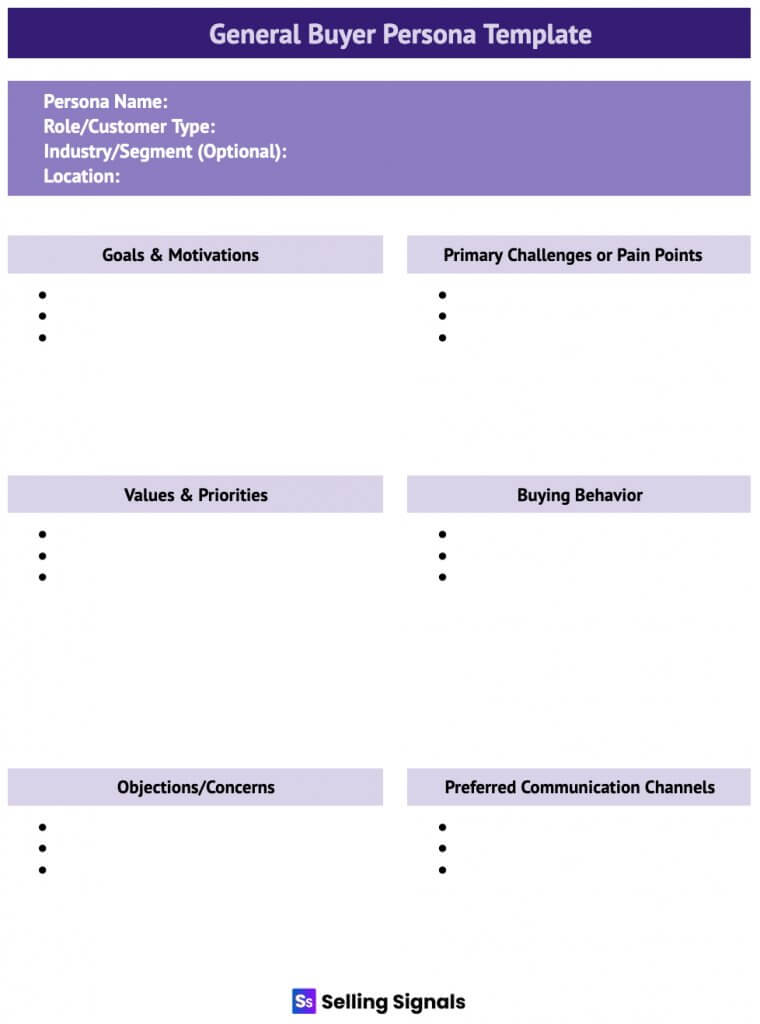
This is a comprehensive persona designed specifically for B2B sales. It includes firmographics, job role, KPIs, challenges, decision criteria, objections, buying triggers, and the buyer’s place in the buying committee.
Developing personas at this level of depth isn’t just best practice; it's also a measurable advantage. In fact, 82% of top-performing B2B marketers say that understanding their audience at a detailed, role-specific level is central to their success.
Who should use it: Sales, marketing, and product teams who need a full understanding of their ideal B2B customer.
Why it works: It captures the business context, internal politics, and role-specific motivations that shape B2B buying decisions.
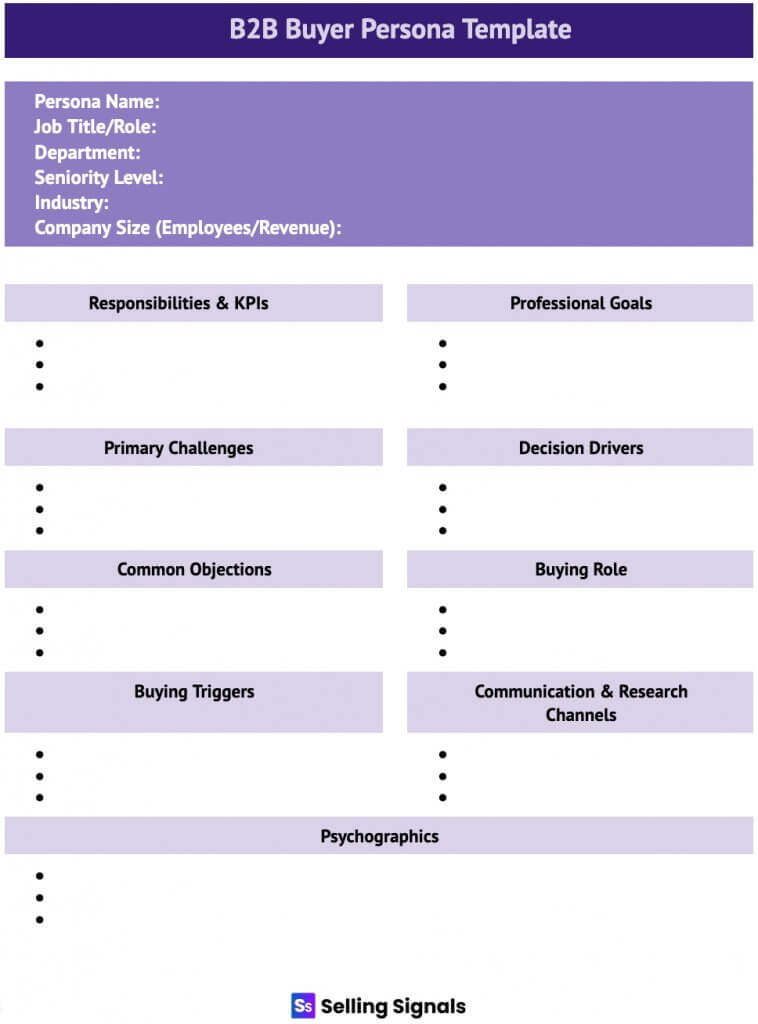
This is a sales-focused persona that gives reps the fast, actionable insights needed to run effective discovery calls, qualify leads, and tailor outreach.
Who should use it: Sales reps, Sales Development Representatives (SDRs), and account executives handling outbound, inbound, or discovery.
Why it works: It highlights the persona’s objections, triggers, buying signals, and communication preferences. This helps reps personalize conversations immediately.
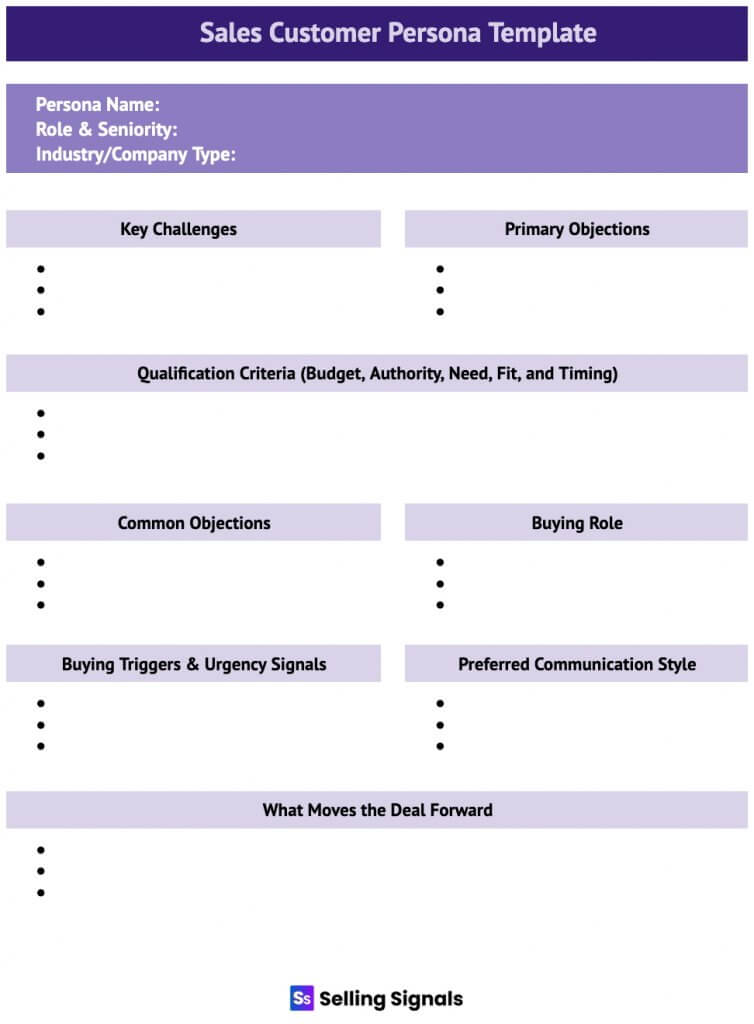
This is a persona built for the executive or leader responsible for approving the budget or finalizing purchases. It emphasizes ROI concerns, strategic priorities, and risk management.
Who should use it: Anyone selling to directors, VPs, C-suite leaders, or budget owners.
Why it works: It focuses on the high-level priorities that actually drive executive decisions, allowing sellers to speak their language.
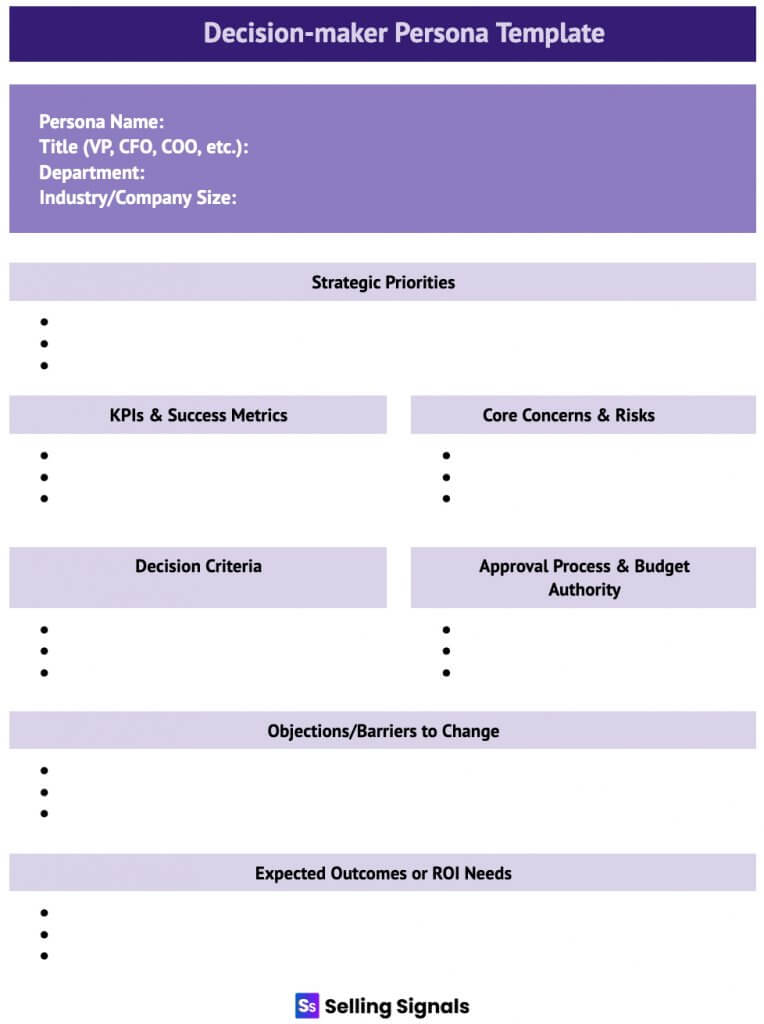
This persona is focused on employees who research solutions, compare vendors, and make recommendations internally. These are often analysts, managers, or technical evaluators.
Who should use it: Marketing teams and sales reps targeting internal champions or technical evaluators.
Why it works: It speaks directly to their day-to-day pain points and research habits, making it easier to win their advocacy.

This is a persona that identifies poor-fit leads — those with low budgets, low urgency, wrong industries, or inadequate authority.
Who should use it: Sales, SDR, marketing, and RevOps teams focused on improving efficiency and lead quality.
Why it works: It prevents wasted time by clearly signaling who shouldn’t enter your pipeline or be nurtured heavily.
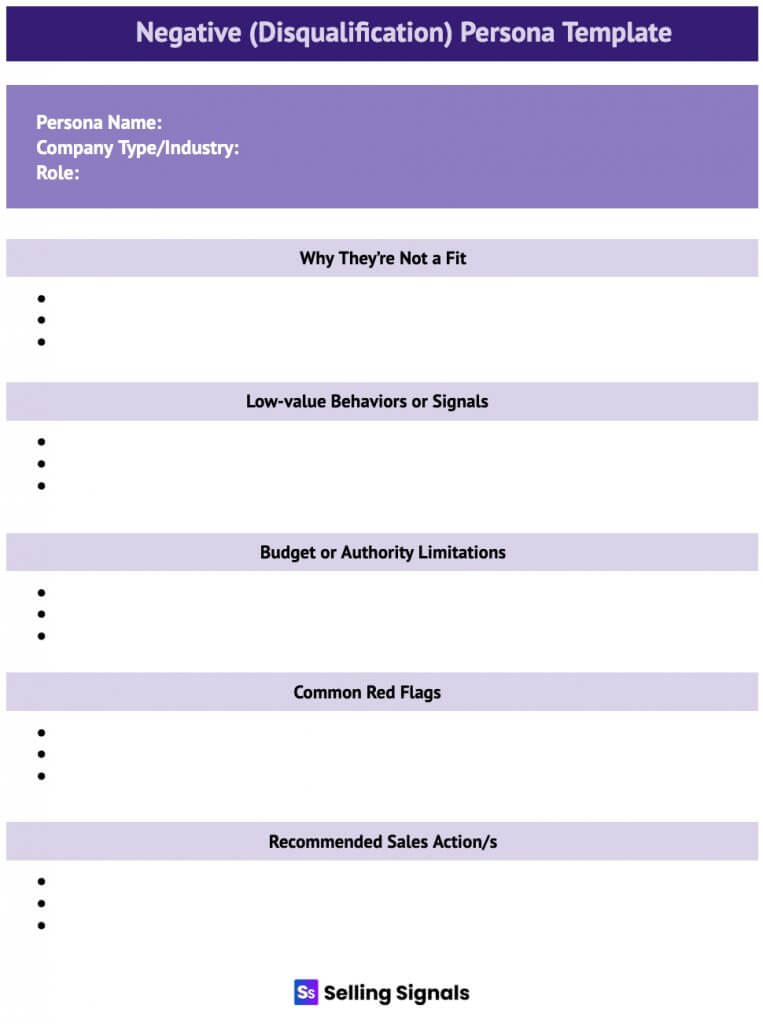
Below are three fully developed example buyer personas that demonstrate how your templates work in practice. These represent the most critical roles in the B2B buying process: the decision-maker, the evaluator, and the end user.
Persona name: Operations Olivia
Title: VP of Operations
Department: Operations
Industry/company size: SaaS, 300–700 employees
Strategic priorities
KPIs and success metrics
Core concerns and risks
Decision criteria
Approval process and budget authority
Objections/barriers to change
Expected outcomes or ROI needs
Persona name: IT Director Ian
Role: IT Director
Department: IT
Company size/industry: Fintech, 500–1,200 employees
Daily responsibilities
Pain points and workflow issues
Feature preferences and evaluation criteria
Information sources
Internal influence level
Objections and concerns
Persona name: HR Manager Helena
Job title/role: HR Manager
Department: Human Resources
Seniority level: Mid-level
Industry: Professional Services
Company size: 100–500 employees
Responsibilities and KPIs
Professional goals
Primary challenges
Decision drivers
Common objections
Buying role
Buying triggers
Communication and research channels
Psychographics
These examples illustrate how each template translates into a clear, actionable buyer profile that your sales and marketing teams can immediately use. As you build your own personas, tailor each one to reflect the roles, challenges, motivations, and decision dynamics unique to your market.
The more specific and data-driven your personas are, the more effectively they’ll guide your messaging, qualification, and outreach.
Buyer persona templates typically include several core components that paint a clear picture of your ideal customer. These sections, which are found in our free general template, help you understand not just who your buyer is, but also why they buy.
Most personas distill each component into a handful of bullet points, though some teams prefer table-based or narrative formats. Below is a breakdown of each component and the strategic insight it provides.
Personas are more memorable and useful when they feel human. Assign a name that reflects a defining trait (e.g., “Technology Tristan,” “Operations Olivia”) and add a simple stock image or illustration. This helps sales and marketing teams visualize the persona as a real person, not a data set.
Demographic details (such as age, location, job title, income, and career stage) provide foundational context about the individual behind the purchase.
Unlike a broader customer profile, which covers ranges and segments, a buyer persona focuses on one specific fictional person. If you want to build this foundation first, learn how to create a customer profile before developing your personas.
Lifestyle details like hobbies, personal interests, and professional learning goals add helpful color to the persona. These insights can support warmer sales conversations and inspire more relevant content, especially in relationship-driven sales cycles where rapport matters.
This section captures what drives the buyer both professionally and personally. Motivations explain their deeper aspirations, while goals outline what they’re actively trying to achieve. Knowing both allows you to craft messaging that resonates with their priorities and positions your offering as the clearest path to success.
Challenges highlight what’s getting in the buyer’s way, whether it’s operational inefficiency, knowledge gaps, resource constraints, or personal frustrations. Understanding these pains enables your team to align your solution with the buyer’s urgent problems, making your pitch feel relevant and timely.
Fears reveal the risks or negative outcomes your buyer wants to avoid. These could include missing targets, choosing the wrong vendor, wasting budget, harming their reputation, or stalling their career. Addressing these anxieties in your messaging helps reduce friction and builds trust during the buying process.
This section clarifies where and how your persona prefers to consume information, which could be via email, LinkedIn, referrals, or webinars. Aligning your outreach with these channels increases engagement, improves conversion rates, and ensures your message reaches the buyer at the right moment.
Understanding how your buyers prefer to communicate makes your outreach more relevant. This matters since 56% of consumers say they’re more likely to become repeat buyers after a personalized experience
If you create your own buyer persona template from scratch, there are some best practices to follow to ensure you create a template that’s easy to fill out and effective once complete.
These tips are to add specialized sections, update the template regularly, craft more than one buyer persona, and reference your customer profile during the creation process.
If you follow the above steps, you should have one or multiple templates that help your marketing, sales, and product teams understand their target buyer. It will also help you perform more productive lead generation activities like outreach and qualification.
An Ideal Customer Profile (ICP) describes the ideal company, while a buyer persona describes the individual people within that company who influence or make the purchase.
Most businesses need two to five personas. This could include a primary buyer, a decision-maker, one or two influencers/evaluators, and a negative persona to filter out bad-fit leads.
Use interviews, CRM data, customer surveys, win/loss analysis, support tickets, sales feedback, and insights from your marketing analytics.
Most teams should review them every six to 12 months or whenever there is a major shift in the market, customer behavior, or product offering.
Yes. Marketing uses personas to craft targeted content and campaigns, while sales uses them to personalize outreach, qualify leads, and handle objections.
Buyer personas help businesses understand their audience and make smarter, customer-centered decisions. Using ready-made buyer persona templates makes the process faster and easier, since they include the key sections needed to define a buyer’s motivations, challenges, fears, and goals.
Download our templates, customize them to fit your market, and use them as a foundation for more targeted sales and marketing efforts.

Selling Signals delivers actionable advice for sales and marketing professionals. Learn strategies that help you hit targets, strengthen customer relationships, and win more business. Get expert advice on lead generation, sales processes, CRM software, sales management, and account management directly to your inbox.
Property of TechnologyAdvice. © 2025 TechnologyAdvice. All Rights Reserved
Advertiser Disclosure: Some of the products that appear on this site are from companies from which TechnologyAdvice receives compensation. This compensation may impact how and where products appear on this site including, for example, the order in which they appear. TechnologyAdvice does not include all companies or all types of products available in the marketplace.